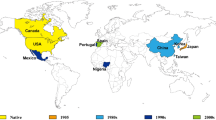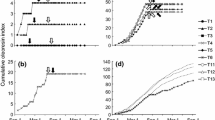Abstract
Pine wilt disease (PWD) is caused by the pinewood nematode (PWN), Bursaphelenchus xylophilus (Steiner et Buhrer) Nickle, and is transmitted by cerambycid beetles. In some pine trees infected with the PWNs in Japan, foliage changes from green to brown in summer to autumn of a nematode infection year (summer- autumn-killed trees) and the others in the following spring of a nematode infection year (spring-killed trees). The vector beetles require 1 or 2 years for development in cool summer areas and 1 year in warm summer areas. To evaluate the effects of the spring-killed trees and vectors with a long developmental time on the PWD epidemics, we presented simple mechanistic mathematical models. The models showed that it was possible for spring-killed trees to cause PWD epidemics when the transmission rate was high, and the efficacy of spring-killed trees as infection source was similar to that of summer– autumn-killed trees. Spring-killed trees and vector beetles with a developmental time of 2 years harbored in summer- autumn-killed trees delayed epidemic timing by 3–10 years or actually suppressed epidemics.







Similar content being viewed by others
References
Anderson RM, May RM (1982) Coevolution of hosts and parasites. Parasitology 85:411–426
Forest Agency (1984) Studies on the new control techniques of pine wilt disease. Forest Agency of Japan, Tokyo (in Japanese)
Kishi Y (1995) The pine wood nematode and the Japanese pine sawyer. Thomas Company, Tokyo
Kiyohara T, Tokushige Y (1971) Inoculation experiments of a nematode, Bursaphelenchus sp. onto pine trees. J Jpn For Soc 53:210–218 (in Japanese with English summary)
Kobayashi T, Sasaki K, Mamiya Y (1974) Fungi associated with Bursaphelenchus lignicolus, the pine wood nematode (I). J Jpn For Soc 56:136–145 (in Japanese with English summary)
Leung B, Forbes MR (1998) The evolution of virulence: a stochastic simulation model examining parasitism at individual and population levels. Evol Ecol 12:165–177
Makihara H (1997) Insect vectors of Bursaphelenchus xylophilus and their life histories. In: Tamura H (ed) The pine wilt disease: the review of history and recent researches. Zenkoku Shinrin Byochujugai Bojo Kyokai (National Forest Pest Control Association), Tokyo, pp 44–64 (in Japanese)
Mamiya Y (1983) Pathology of the pine wilt disease caused by Bursaphelenchus xylophilus. Annu Rev Phytopathol 21:201–220
Mamiya Y, Enda N (1972) Transmission of Bursaphelenchus lignicolus (Nematoda: Aphelenchoididae) by Monochamus alternatus (Coleoptera: Cerambycidae). Nematologica 18:159–162
Mamiya Y, Kiyohara T (1972) Description of Bursaphelenchus lignicolus n. sp. (Nematoda: Aphelenchoididae) from pine wood and histopathology of nematode-infested trees. Nematologica 18:120–124
Nakamura-Matori K (2008) Vector–host tree relationships and the abiotic environment. In: Zhao BG, Futai K, Sutherland JR, Takeuchi Y (eds) Pine wilt disease. Springer, Tokyo, pp 144–161
Økland B, Skarpaas O, Schroeder M, Magnusson C, Lindelöw Å, Thunes K (2010) Is eradication of the pinewood nematode (Bursaphelenchus xylophilus) likely? An evaluation of current contingency plans. Risk Anal 30:1424–1439
Robertson L, Cobacho Arcos S, Escuer M, Santiago Merino R, Esparrago G, Abelleira A, Navas A (2011) Incidence of the pinewood nematode Bursaphelenchus xylophlius Steiner & Buhrer, 1934 (Nickle, 1970) in Spain. Nematology 13:755–757
Robinet C, van Opstal N, Baker R, Roques A (2011) Applying a spread model to identify the entry points from which the pine wood nematode, the vector of pine wilt disease, would spread most rapidly across Europe. Biol Invasions 13:2981–2995
Sato H, Sakuyama T, Kobayashi M (1987) Transmission of Bursaphelenchus xylophilus (Steiner et Buhrer) Nickle (Nematoda: Aphelenchoididae) by Monochamus saltuarius (Gebler) (Coleoptera: Cerambycidae). J Jpn For Soc 69:492–496 (In Japanese with English summary)
Shidei T (1963) Afforestation of Japanese red pine. Chikyu Shuppan, Tokyo (in Japanese)
Shin S-C (2008) Pine wilt disease in Korea. In: Zhao BG, Futai K, Sutherland JR, Takeuchi Y (eds) Pine wilt disease. Springer, Tokyo, pp 26–32
Takasu F (2009) Individual-based modeling of the spread of pine wilt disease: vector beetle dispersal and the Allee effect. Popul Ecol 51:399–409
Togashi K (1989a) Variation in external symptom development of pine wilt disease in field grown Pinus thunbergii. J Jpn For Soc 71:442–448
Togashi K (1989b) Development of Monochamus alternatus Hope (Coleoptera: Cerambycidae) in relation to oviposition time. Jpn J Appl Entomol Zool 33:1–8 (in Japanese)
Togashi K (1989c) Development of Monochamus alternatus Hope (Coleoptera: Cerambycidae) in Pinus thunbergii trees weakened at different times. J Jpn For Soc 71:383–386 (in Japanese)
Togashi K (2008) Vector-nematode relationship and epidemiology in pine wilt disease. In: Zhao BG, Futai K, Sutherland JR, Takeuchi Y (eds) Pine wilt disease. Springer, Tokyo, pp 162–183
Togashi K, Shigesada N (2006) Spread of the pinewood nematode vectored by the Japanese pine sawyer: modeling and analytical approaches. Popul Ecol 48:271–283
Togashi K, Nakamura K, Takahashi F (1992) An index of susceptibility of pine stands to pine wilt disease. Appl Entomol Zool 27:341–347
Yoshimura A, Kawasaki K, Takasu F, Togashi K, Futai K, Shigesada N (1999) Modeling the spread of pine wilt disease caused by nematodes with pine sawyers as vector. Ecology 80:1691–1702
Zhao BG (2008) Pine wilt disease in China. In: Zhao BG, Futai K, Sutherland JR, Takeuchi Y (eds) Pine wilt disease. Springer, Tokyo, pp 18–25
Zinno Y, Takizawa Y, Sato H (1987) Characteristics and management strategy of pine wilt disease in cool and high-altitude areas. Ringyo Kagaku Gijutsu Shinko Sho, Tokyo (in Japanese)
Acknowledgments
This work was supported in part by Grants-in-Aid for scientific research from JSPS (nos. 18208013 and 22380081).
Author information
Authors and Affiliations
Corresponding author
Rights and permissions
About this article
Cite this article
Togashi, K., Nakamura, K. & Jikumaru, S. Effects of spring-killed pine trees on the epidemics of pine wilt disease. Appl Entomol Zool 47, 311–318 (2012). https://doi.org/10.1007/s13355-012-0121-y
Received:
Accepted:
Published:
Issue Date:
DOI: https://doi.org/10.1007/s13355-012-0121-y




